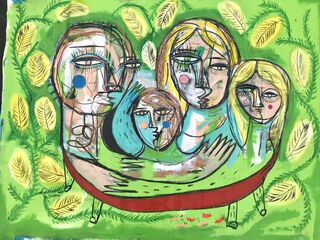Relationships
Enhancing Community and Meaning Through Art
Two questions to build connections and fall in love with art.
Posted September 14, 2022 Reviewed by Vanessa Lancaster
Key points
- We do not need special training in the arts for them to contribute to our well-being and flourishing.
- Despite this possibility of transcendence, art sometimes evades us.
- Curiosity and attentive vulnerability can make art more accessible.
The arts have the ability to touch something essential in us. When my oldest was five, I went to the local library and checked out several print books of various masters: Chagall, Matisse, Rubens, Warhol, Picasso, and Pollack. As we would flip the pages together, he was drawn to certain works and uninspired by others.
I asked two questions: 1) How does the painting make you feel? and 2) What about the work that made you feel that way? With two simple queries, I was able to keep our child entertained for hours.
We have a special relationship with the arts: painting, sculpture, literature, cinema, and music. These gifts of the muse have been a fundamental part of the human experience and serve many functions in our lives. Our ancestors made ceramic figurines, bird bones, and ivory flutes over 35,000 years ago, long before the first vessels for grain.
People tremble with an ardent fervor when they speak of Rothko’s color field paintings. Walt Whitman was called a prophet. The films of Andrei Tarkovsky are “prayers through cinema.” These religious metaphors are not just hyperbole. In September 1982, the jazz saxophonist John Coltrane was canonized as a patron saint.

However, despite this possibility of transcendence, art sometimes evades us. We may come across a painting that we find beautiful or a song that makes us want to dance, but we cannot discern how they have relevance to the raw and mundane imperatives we must face every day.
I have often wandered among the works of a museum or thumbed a modernist classic without any notion of what any of it has to do with real life.
After our playful inquiries over catalogues of paintings, I took our son to the Joslyn Art Museum in Omaha, Nebraska. The Joslyn has a tremendous collection of Paolo Veronese, El Greco, Renoir, Rembrandt, Degas, Pissarro, and Grant Wood, among others. It also has numerous important Western American and Native American treasures.
Five-year-old boys are not known for their concentrated focus, let alone an ability to wander attentively around museum spaces. Yet, with these two simple questions, our child remained engaged for the entire day.
We were not just looking at pictures on a wall but were actively engaging with the works and learning to identify and connect with our feelings. By attending to the subtleties of lines and hues and the placement of things, we saw how simple strokes could color a whole emotional life. By doing this together–asking questions, discussing, and exploring–the experience became communal too.

There are still myriad classic works that I do not “understand”: What makes this “art”? Out of all of the possibilities, why did the curator select this piece? How could someone pay so much for it? A deeper study of painting, music, or poetry would open the work further.
However, curiosity, attentive vulnerability, and two simple questions made these pieces accessible, taught me something about myself and made the works personally meaningful.
Importantly, they created a doorway into a shared experience–connecting me to people across time and space and bridging the time between parent and child.
References
Ancient flutes suggest rich life in stone-age Europe. Science. (2009, June 24). Retrieved September 13, 2022, from https://www.science.org/content/article/ancient-flutes-suggest-rich-life-stone-age-europe.
Bucke, R,M. (1901) Cosmic Consciousness.
Janus Films / Film Capital Stockholm. (2019). Andrey Tarkovsky. A Cinema Prayer. Italy. Retrieved September 10, 2022, from https://www.youtube.com/watch?v=qZ7q2D2TaB4.
Miller, M. H. (2021, December 3). The Canonization of Saint John Coltrane. The New York Times Style Magazine. Retrieved May 12, 2021, from https://www.nytimes.com/2021/12/03/t-magazine/john-coltrane-church.html.
Special thanks to artist Nico Amortegui, for generous permission to use his art work in this post. http://nicoarte.com/


